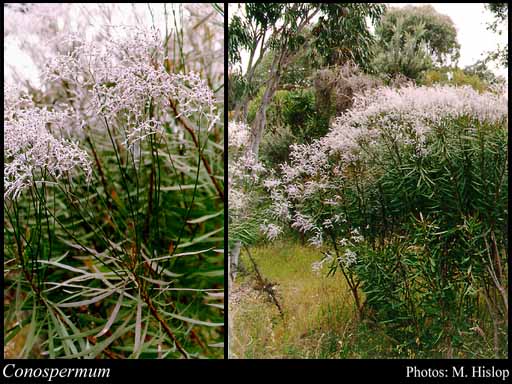- Reference
- Trans.Linn.Soc.London,Bot. 4:213 (1798)
- Name Status
- Current

Scientific Description
Common name. Smokebushes. Family Proteaceae.
Habit and leaf form. Small trees, or shrubs (or undershrubs); evergreen. Leaves basal, or cauline. To 0.3–4 m high. Mesophytic, or xerophytic. Heterophyllous. Leaves small to very large; alternate; usually spiral; leathery; petiolate to sessile; non-sheathing; edgewise to the stem, or with ‘normal’ orientation; simple; epulvinate. Leaf blades entire; flat, or solid; terete, or semi-terete; linear, or ovate, or obovate, or oblong; one-veined, or pinnately veined, or parallel-veined. Mature leaf blades adaxially glabrous, or pubescent; abaxially glabrous, or pubescent. Leaves without stipules. Leaf blade margins entire. Leaves without a persistent basal meristem. Leaf anatomy. Hairs present, or absent. Stem anatomy. Secondary thickening developing from a conventional cambial ring.
Reproductive type, pollination. Fertile flowers hermaphrodite. Unisexual flowers absent. Plants hermaphrodite. Entomophilous.
Inflorescence and flower features. Flowers aggregated in ‘inflorescences’. Inflorescence few-flowered, or many-flowered. Flowers not in pairs subtended by a common bract; in spikes. Inflorescences compound; terminal, or axillary; paniculate or corymbose, of 1-many short, dense spikes. The fruiting inflorescence not conelike. Flowers sessile; bracteolate. Bracteoles persistent (sheathing, broad). Flowers small to medium-sized; regular, or somewhat irregular (with 4 nearly equal lobes), or very irregular (and 2-lipped, the adaxial lip of 1 broad lobe; the abaxial lip 3-lobed); when irregular, zygomorphic. The floral asymmetry when present, involving the perianth and involving the androecium. Flowers 4 merous; cyclic; tetracyclic. Floral receptacle developing a gynophore, or with neither androphore nor gynophore. Free hypanthium absent. Hypogynous disk absent. Perianth of ‘tepals’; 4; 1 -whorled; joined (basally); hairy, or glabrous; white, or cream, or pink, or blue. Androecial members definite in number. Androecium 4. Androecial members adnate (to tepals); all equal, or markedly unequal; free of one another, or coherent; 1 -whorled. Androecium including staminodes. Staminodes 1; representing the anterior median member. Stamens 3; reduced in number relative to the adjacent perianth. Filaments short, thick. Anthers separate from one another, or cohering (initially, the loculi of adjacent anthers cohering in the bud); basifixed; non-versatile; dehiscing via longitudinal slits; introrse; unilocular (lateral stamens), or bilocular (adaxial stamen); tetrasporangiate. Gynoecium 1 carpelled. The pistil 1 celled. Gynoecium monomerous; of one carpel; superior. Carpel stylate; apically stigmatic. Style curved (incurved abaxially, beaked; pollen presenter absent; stigma lateral, subterminal). Carpel 1 ovuled. Placentation marginal, or apical. Ovary sessile. Ovules funicled, or sessile; pendulous; non-arillate; orthotropous, or anatropous, or amphitropous, or hemianatropous.
Fruit and seed features. Fruit non-fleshy; often hairy, or not hairy. The fruiting carpel indehiscent; nucular (nut obconical or urceolate). Seeds non-endospermic. Embryo well differentiated. Cotyledons 2(–8). Embryo straight.
Special features. Stamens inserted within the floral tube (or in base of lower lip). Staminodes free of the stigma.
Geography, cytology, number of species. Native of Australia. Endemic to Australia. Australian states and territories: Western Australia, South Australia, Queensland, New South Wales, Victoria, Australian Capital Territory, and Tasmania. Eremaean Botanical Province and South-West Botanical Province. N=11.
Etymology. From the Greek for "cone" and "seed"; refers to the shape of the nut.